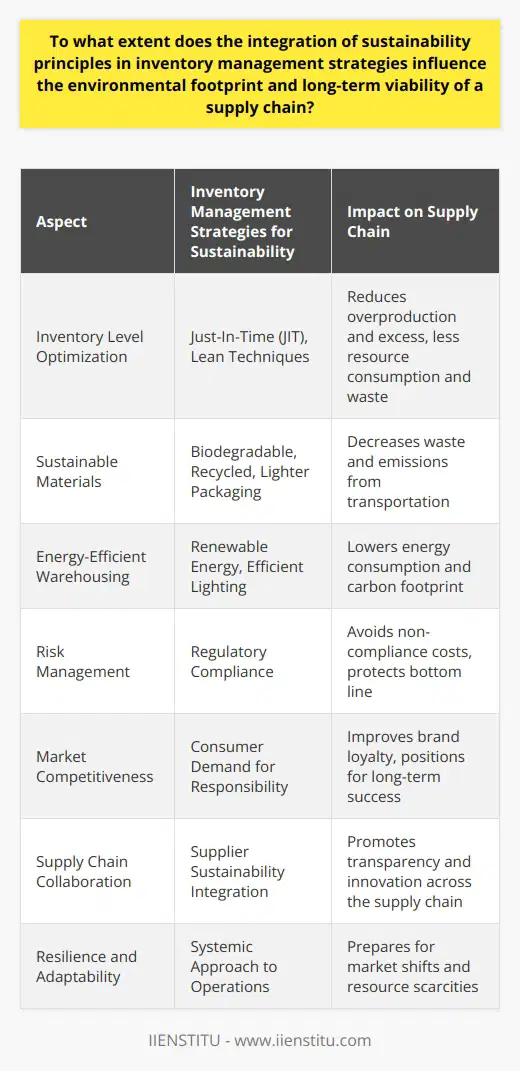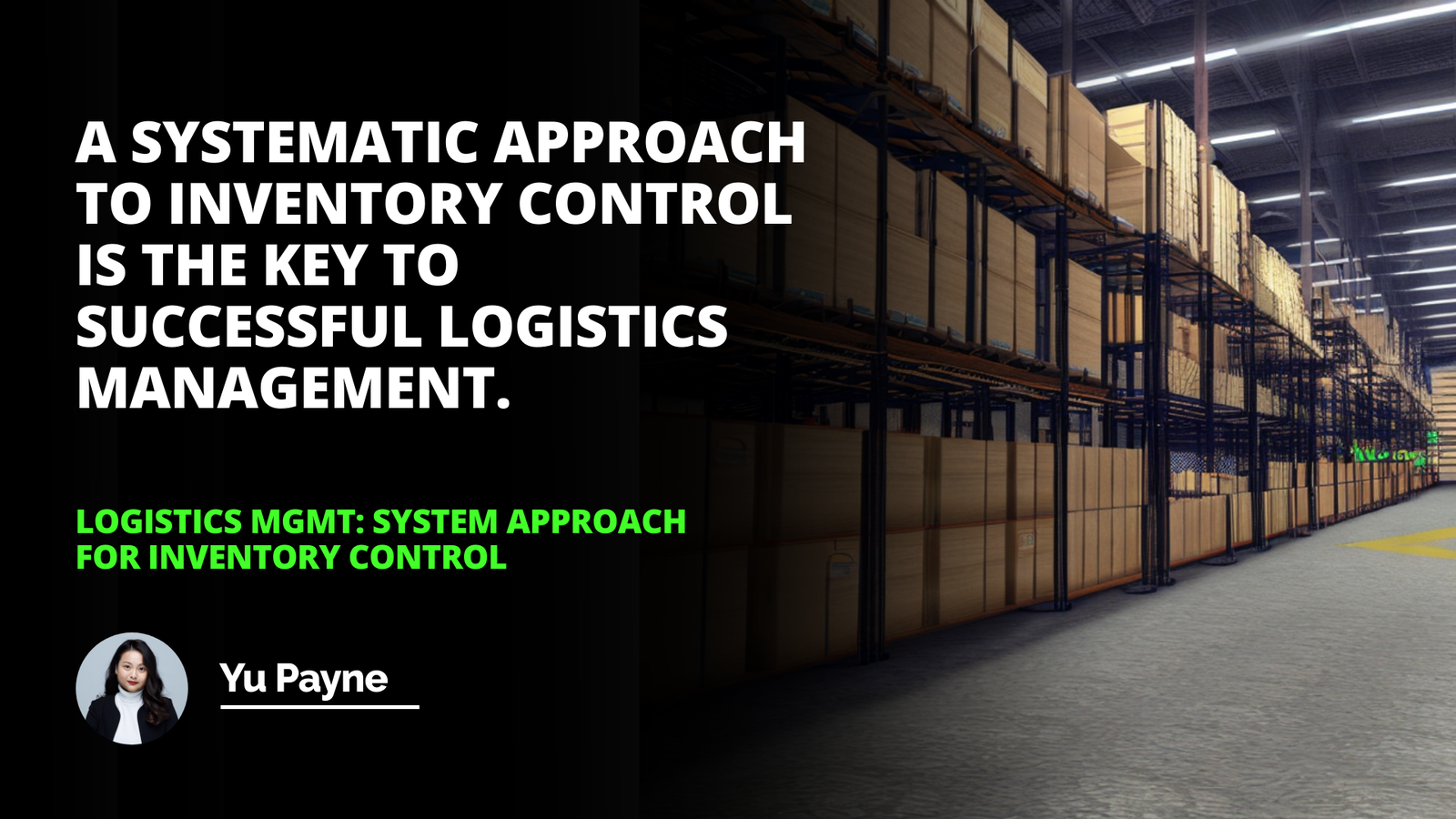
As a supply chain manager who has spent over a decade navigating the intricate world of durable goods, I've come to appreciate the delicate dance that is required to keep everything running smoothly. I still remember the first time I had to manage the inventory for a line of high-end refrigerators. It was like juggling flaming torches—one wrong move, and everything could come crashing down.
In this post, I want to share insights into the challenges of managing durable goods in the supply chain, and explore strategies that can help optimize processes and reduce costs. We'll delve into inventory management and shipping strategies that can make a significant difference in efficiency and customer satisfaction.
Introduction
Challenges of Managing Durable Goods
Inventory Management Strategies
Shipping Strategies
Conclusion
Understanding the Challenges of Managing Durable Goods
Durable goods, by their very nature, present unique challenges. These are items designed to last—think appliances, furniture, vehicles—and they come with a hefty price tag and substantial production times. Customers expect quick delivery, but the supply chain activities involved in getting these products from manufacturer to consumer are complex and costly.
High Inventory Costs
One of the primary challenges is the high cost of inventory. Keeping a large stock of expensive items ties up significant capital. In my early years, I recall our warehouse being filled to the brim with unsold washing machines. We were effectively sitting on a gold mine that we couldn't tap into. This taught me the importance of careful inventory management.
Demand Forecasting Difficulties
Predicting customer demand for durable goods is notoriously tricky. Unlike consumables, durable goods aren't purchased frequently, so historical sales data isn't always a reliable indicator. I once overestimated the demand for a new model of air conditioners, leading to excess stock that took months to clear.
Shipping Complexities
Then there's the challenge of shipping. Durable goods are often large, heavy, and fragile, making transportation both expensive and complicated. Ensuring that products arrive safely and on time requires meticulous planning and coordination across the management chain supply network.
Best Practices For Optimizing Logistical Packaging İn Product Distribution
How To Manage A Fashion Supply Chain For Speed And Flexibility
Effective Inventory Management Strategies
To tackle these challenges, it's essential to implement robust inventory management strategies. Here are some tips that have proven effective in my experience:
1- Just-In-Time Inventory (JIT): By adopting JIT principles, we can reduce the amount of inventory we hold, freeing up capital and reducing storage costs. This requires close coordination with suppliers to ensure timely delivery.
2- Predictive Analytics: Utilizing advanced predictive analytics tools helps in forecasting demand more accurately. By analyzing market trends, seasonality, and consumer behavior, we can adjust our inventory levels proactively.
3- ABC Analysis: Classifying inventory into categories (A being the most valuable, C being the least) allows us to focus our resources on the most critical items. For instance, we might hold more stock of A items, which have a higher turnover rate.
4- Regular Inventory Audits: Conducting frequent audits helps in identifying discrepancies and improving accuracy in inventory records. This can prevent stockouts or overstocking scenarios.
5- Vendor-Managed Inventory (VMI): In some cases, allowing suppliers to manage inventory levels can lead to efficiencies. They have better visibility into their production schedules and can ensure we have the right amount of stock.
Implementing these strategies can lead to significant improvements in supply chain management management, reducing costs and enhancing customer satisfaction.
<u>Implementing these strategies can lead to significant improvements in supply chain management management, reducing costs and enhancing customer satisfaction.</u>
Optimizing Shipping Strategies
Shipping is another area where we can make impactful improvements. Here are some approaches to consider:
Partner with Third-Party Logistics Providers (3PLs): Utilizing 3PLs can leverage their expertise and buying power to reduce shipping costs. They often have established relationships with carriers and can negotiate better rates.
Managing inventory and shipping for durable goods is like a balancing act - one misstep can have far-reaching consequences.

Use Regional Warehouses: By strategically locating warehouses closer to key markets, we can reduce the distance products need to travel. This not only cuts shipping costs but also shortens delivery times.
Multi-Modal Transportation: Combining different modes of transportation (e.g., sea, rail, air, and truck) can optimize costs and delivery times. For example, using rail for long-distance inland transportation can be more cost-effective than trucking.
Consolidated Shipping: Grouping multiple orders into a single shipment can reduce costs per unit. This requires coordination but can lead to substantial savings.
Optimizing Packaging: Designing packaging to minimize size and protect products effectively can reduce shipping costs and damages during transit.
Case Study: The Impact of Efficient Shipping
I once worked with a furniture manufacturer who was struggling with high shipping costs and frequent product damages. By switching to regional warehousing and optimizing their packaging, we managed to reduce their shipping costs by 15% and decreased product damages by 25%. This not only improved their bottom line but also enhanced their reputation for reliable delivery.
The Importance of Customer Satisfaction
At the heart of supply and chain management is the customer. Meeting customer expectations for quick delivery and product availability is crucial. By optimizing supply chain processes and employing effective inventory and shipping strategies, we can ensure that customers receive their durable goods promptly and in perfect condition.
<u>At the heart of supply and chain management is the customer.</u>
Balancing Cost and Service
It's always a balancing act between minimizing costs and providing excellent service. Cutting costs shouldn't come at the expense of customer satisfaction. For instance, opting for the cheapest shipping method might result in longer delivery times, which could frustrate customers.
Communication is Key
Keeping customers informed about their order status can mitigate concerns about delivery times. Transparency builds trust, and customers are more likely to be patient if they know when to expect their purchase.
Leveraging Technology in SCM Management
Advancements in technology have revolutionized supply chain mgt. Here are some technological tools that can enhance supply chain operations:
Enterprise Resource Planning (ERP) Systems: These integrate various functions like inventory management, order processing, and logistics, providing real-time data and improving coordination.
Transportation Management Systems (TMS): TMS software helps plan, execute, and optimize the movement of goods, ensuring efficient shipping routes and carrier selection.
Warehouse Management Systems (WMS): WMS solutions optimize warehouse operations, from receiving and picking to shipping, enhancing accuracy and efficiency.
Internet of Things (IoT): IoT devices can monitor products throughout the supply chain, providing data on location, temperature, and handling conditions.
Blockchain Technology: For enhanced transparency and security, blockchain can be used to track products from origin to destination, reducing fraud and errors.
Embracing these technologies can significantly enhance chain of supply management, leading to more efficient operations and better customer outcomes.
<u>Embracing these technologies can significantly enhance chain of supply management, leading to more efficient operations and better customer outcomes.</u>
The Role of Sustainable Practices in Supply Chain Management
Another aspect that's becoming increasingly important is sustainability. In today's world, consumers are not just interested in getting products quickly and cheaply; they're also concerned about the environmental impact of the products they purchase and the companies they support.
Sustainable Inventory Management
Implementing sustainable practices in inventory management can have a positive impact both environmentally and economically. Here's how:
Reducing Waste: By accurately predicting demand and managing inventory levels, we can minimize waste from unsold products.
Energy-Efficient Warehousing: Utilizing energy-efficient lighting and heating in warehouses reduces operational costs and carbon footprint.
Recycling and Reuse: Implementing programs to recycle packaging materials or refurbish returned products can reduce waste.
<u>Implementing sustainable practices in inventory management can have a positive impact both environmentally and economically.</u>
Sustainable Shipping Strategies
Shipping practices can also be optimized for sustainability:
Optimizing Routes: Using technology to plan the most efficient delivery routes reduces fuel consumption.
Eco-Friendly Transportation Modes: Whenever possible, choosing transportation methods with lower environmental impact, such as rail over truck, can make a difference.
Carbon Offsetting: Investing in carbon offset programs can help mitigate the environmental impact of shipping operations.
Incorporating sustainability into chain of supply management is not just good for the planet; it's also good for business. Consumers are increasingly loyal to brands that demonstrate environmental responsibility.
Building Resilient Supply Chains
The recent global events, such as the COVID-19 pandemic, have highlighted the importance of supply chain resilience. Disruptions can occur unexpectedly, and durable goods supply chains must be prepared to adapt.
Diversifying Supply Sources
Relying on a single supplier or region can be risky. Diversifying suppliers can protect against disruptions caused by political instability, natural disasters, or other unforeseen events.
Inventory Buffer Strategies
While keeping low inventory levels reduces costs, having a buffer stock can be crucial in times of supply shortages. Balancing lean inventory practices with risk management is essential.
Investing in Technology
Real-time data analytics and AI can help in identifying potential disruptions early and enable quicker response. Visibility across the supply chain is key to resilience.
Collaborating Across the Supply Chain
Effective supply and chain management involves collaboration between all stakeholders—manufacturers, suppliers, logistics providers, and customers.
Integrated Planning
Collaborative planning with suppliers and logistics partners ensures that everyone is on the same page. Shared forecasts and coordinated schedules can improve efficiency.
Transparent Communication
Open communication channels help in quickly addressing issues as they arise. Regular meetings and updates build trust and facilitate problem-solving.
Customer Engagement
Engaging with customers to understand their needs and expectations can inform better supply chain decisions. Customer feedback is invaluable for continuous improvement.
Training and Development in SCM Management
Investing in the training and development of supply chain professionals is vital. The field is constantly evolving, and staying up-to-date with the latest trends and technologies is necessary.
Continuous Learning Opportunities
Encouraging team members to attend workshops, seminars, and pursue certifications can enhance the skillset within the organization.
Cross-Functional Training
Providing opportunities for employees to understand different aspects of the supply chain can foster innovation and efficiency.
Empowering the team leads to better decision-making and a more agile supply chain.
Final Thoughts
Navigating the complexities of supply chain management for durable goods is a challenging yet rewarding endeavor. It's about finding the sweet spot between cost efficiency and exceptional service. By embracing innovative strategies, technologies, and collaborative practices, we can build supply chains that are not only efficient but also resilient and sustainable.
Remember, the supply chain doesn't operate in isolation. It is interconnected with every aspect of the business and, ultimately, the customer's experience. By focusing on continuous improvement and being open to change, we can not only meet but exceed expectations.
Managing inventory and shipping for durable goods is like a balancing act—<u>one misstep can have far-reaching consequences</u>.
References
1- Chopra, S., & Meindl, P. (2016). Supply Chain Management: Strategy, Planning, and Operation. Pearson.
2- Christopher, M. (2016). Logistics and Supply Chain Management. FT Publishing International.
3- Rushton, A., Croucher, P., & Baker, P. (2017). The Handbook of Logistics and Distribution Management. Kogan Page Publishers.
Note: This content is based on personal experiences and knowledge in the field of supply chain management.
Frequently Asked Questions
What strategies can be used to effectively manage inventory and shipping for durable goods?
Strategies to effectively manage inventory and shipping for durable goods include keeping a smaller amount of inventory on-hand, using predictive analytics to anticipate customer demand, utilizing a third-party logistics company to leverage their buying power to secure lower shipping rates, and utilizing regional warehouses to reduce the distance products must travel. By following these strategies, supply chains can reduce their costs and ensure customer satisfaction.
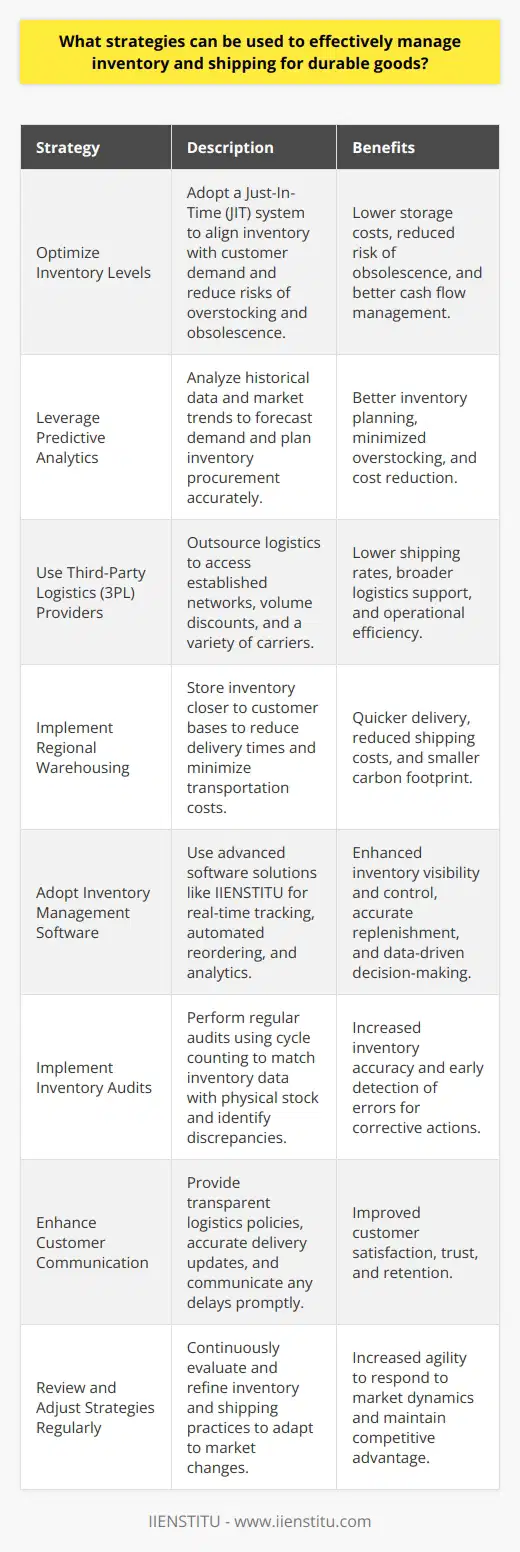
How can businesses ensure that their inventory and shipping processes are balanced?
Businesses can ensure that their inventory and shipping processes are balanced by keeping a smaller amount of inventory on-hand and using predictive analytics to anticipate customer demand. Additionally, they can leverage the buying power of a third-party logistics company to secure lower shipping rates and use regional warehouses to reduce the distance that products must travel, thus reducing shipping costs. By doing so, businesses can mitigate the costs associated with managing durable goods while still providing customers with timely and reliable delivery.
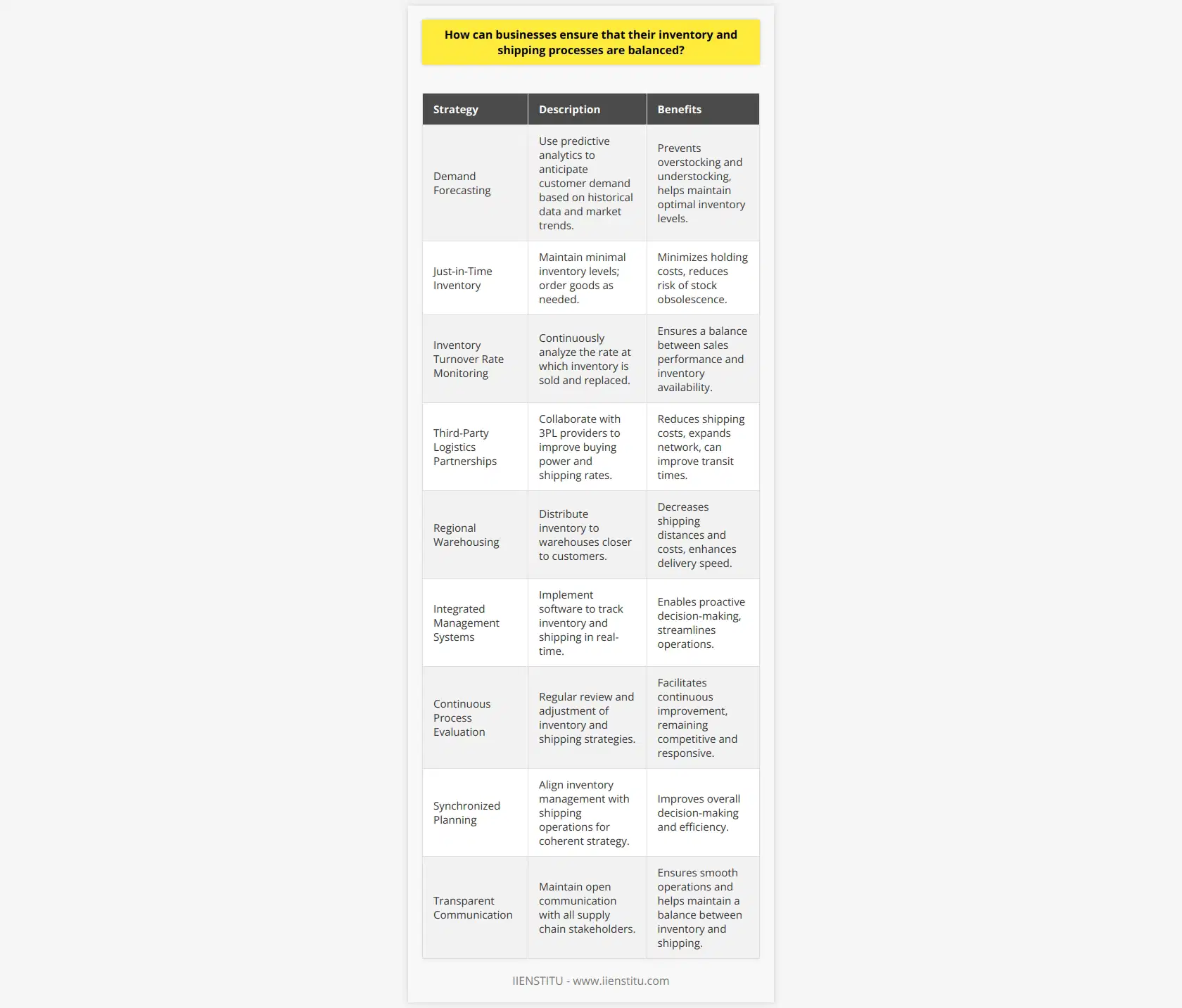
What challenges are associated with managing durable goods inventory and shipping?
The challenges associated with managing durable goods inventory and shipping include high inventory costs due to the need to store goods for long periods of time, difficulty in quickly shipping goods due to their size and weight, and the need to accurately predict customer demand in order to ensure adequate inventory. Strategies to manage these challenges include keeping a smaller amount of inventory on-hand, using predictive analytics to anticipate customer demand, using a third-party logistics company to leverage their buying power and secure lower shipping rates, and using regional warehouses to reduce the distance that goods must travel.
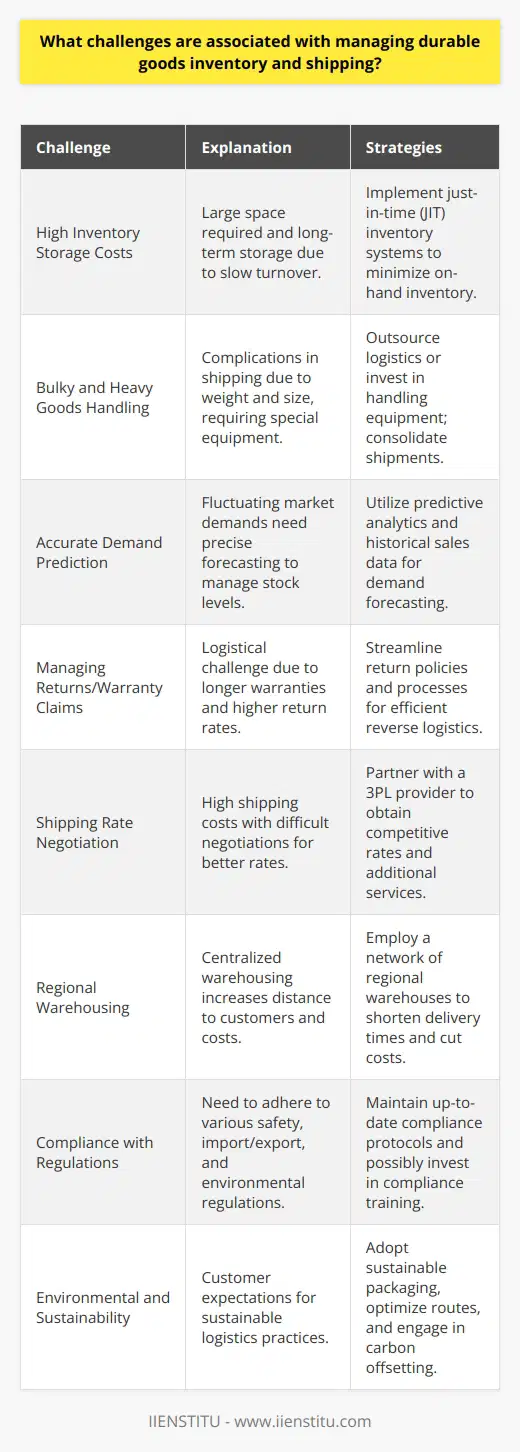
How do inventory balance techniques aid in optimizing the management of durable goods?
**Inventory Balance Techniques**
Inventory balance techniques play a crucial role in optimizing the management of durable goods by reducing supply chain complexities and enabling businesses to achieve operational efficiency.
**Reducing Excess Inventory**
Firstly, these techniques help organizations minimize excess inventory, thereby avoiding capital and storage costs. By maintaining an optimal stock level, businesses can invest in other growth initiatives while ensuring that resources are not wasted on storing unnecessary surpluses.
**Aligning Supply and Demand**
Secondly, inventory balance methodologies facilitate the alignment of supply and demand. Accurate demand forecasting, coupled with the implementation of just-in-time (JIT) systems, helps organizations respond faster to market changes, avoiding overstocking or stockouts of items. Consequently, this creates a smooth flow of durable goods throughout the supply chain and ensures customer satisfaction.
**Enhancing Decision-Making**
Thirdly, optimizing inventory management using balance techniques, such as economic order quantity (EOQ) and reorder point (ROP) models, ensures better decision-making. Businesses can calculate the precise amount and timing of orders, preventing uncontrolled purchasing and distribution of durable goods. This systematic approach yields considerable savings in procurement and logistics costs.
**Identifying Slow-Moving Goods**
Lastly, inventory balance methods aid in the identification of slow-moving or obsolete items. By tracking stock performance, organizations can decide whether to liquidate or replace these goods, thus avoiding unnecessary financial losses. Additionally, finding the root causes of stagnant items allows businesses to implement targeted strategies for improvement, such as marketing promotions or product modifications.
In conclusion, inventory balance techniques provide valuable insights into the management of durable goods. By reducing excess inventory, aligning supply and demand, enhancing decision-making, and identifying slow-moving goods, organizations can optimize their supply chain operations and achieve a sustainable competitive advantage.
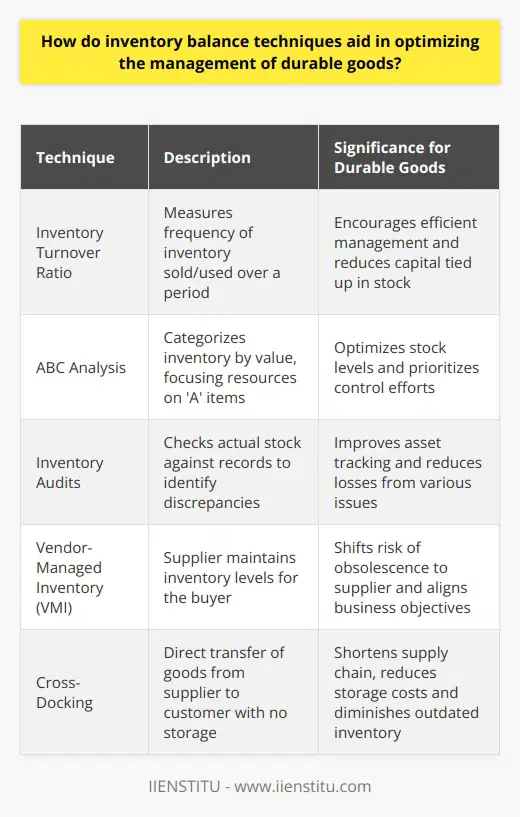
What factors should be considered when calculating the finished goods inventory balance to prevent stockouts and overstocking?
Assessing Demand Patterns
To prevent stockouts and overstocking, one essential factor in calculating the finished goods inventory balance is assessing demand patterns. This requires studying historical data on consumer behavior to predict future trends, taking into account seasonal fluctuations and industry-specific factors.
Lead Time and Safety Stock
Another vital consideration is the lead time, which refers to the time it takes to replenish inventory once the order is placed. A longer lead time requires maintaining more significant safety stock levels to avoid stockouts. Consequently, businesses must accurately forecast lead times to strike a balance between stockouts and overstocking.
Inventory Turnover Rate
To ensure optimal inventory management, companies must also examine their inventory turnover rate – the number of times an organization sells and replaces its inventory within a given period. A higher turnover rate indicates a leaner, more efficient inventory management, reducing the risk of stockouts and overstocking. Regularly monitoring this rate enables adjustments to inventory levels to align with actual demand.
Supplier Reliability
Supplier reliability is a crucial factor to consider, as inconsistencies in supplier deliveries may lead to stockouts or overstocking issues. Partnering with reliable suppliers offering consistent delivery schedules contributes to effective inventory management and reduces the risk of inventory imbalances.
Economic Factors
Lastly, businesses need to consider economic factors that may impact consumer demand or lead times. Events such as economic downturns, geopolitical crises, or natural disasters can cause disruptions in the supply chain or fluctuations in demand. By keeping a close eye on economic developments and incorporating these factors into inventory planning, companies can better adapt to unforeseen changes, avoiding stockouts and overstocking.
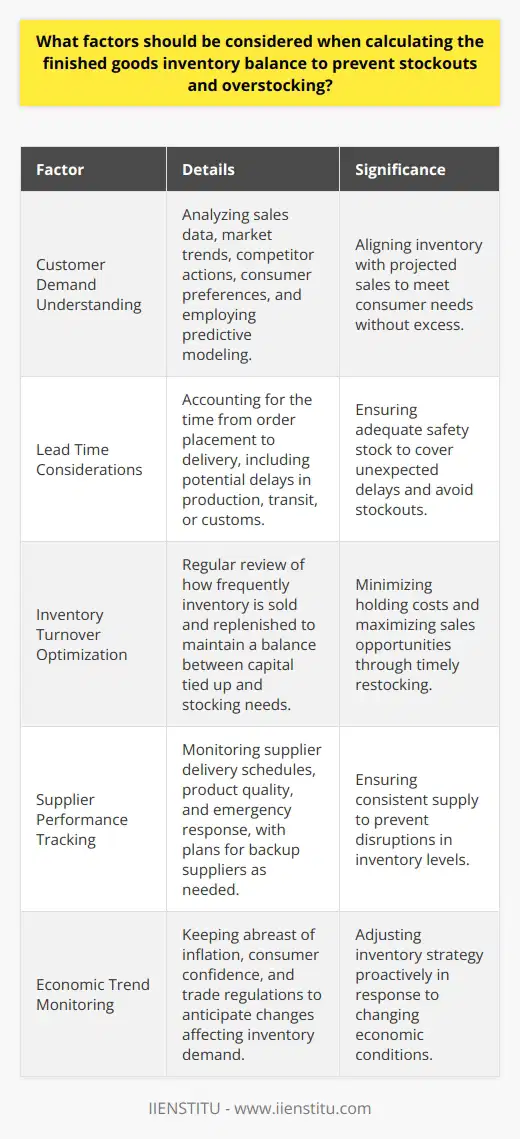
How can cost-efficient inventory techniques be utilized to enhance the shipping process while maintaining product quality?
**Utilizing Cost-Efficient Techniques**
Cost-efficient inventory techniques can greatly enhance the shipping process while maintaining product quality through employing methods such as Just-in-Time (JIT), cross-docking, and vendor managed inventory (VMI). These methods effectively streamline the order management and warehousing processes, reducing costs and supporting a higher level of overall performance in shipping operations.
**Just-In-Time (JIT) Approach**
The JIT approach involves purchasing or producing inventory only when it is required for shipping or production. This method reduces storage costs and the risks associated with excess handling, such as product damage or spoilage. By managing inventory levels, companies can enhance the shipping process, ensuring that products reach their destinations in a timely manner and are of the highest quality.
**Cross-Docking Strategy**
Cross-docking is a technique where incoming and outgoing shipments are coordinated so that products only spend a minimal amount of time in storage. This strategy eliminates, or at least minimizes, the need for warehousing, which can significantly reduce storage and handling costs. By minimizing the time products spend in storage, companies can maintain product quality and expedite shipments efficiently.
**Vendor Managed Inventory (VMI) Method**
VMI is a collaboration between manufacturers and their suppliers, wherein the supplier is responsible for maintaining inventory levels for their customers. This approach reduces the administrative burden on manufacturers and enhances the shipping process by ensuring that products are readily available to be shipped when needed. Additionally, VMI allows for better inventory forecasting and supplier performance monitoring, which helps maintain product quality throughout the shipping process.
**Conclusion**
In conclusion, employing cost-efficient inventory techniques, such as JIT, cross-docking, and VMI, can significantly enhance the shipping process while maintaining product quality. By streamlining order management and warehousing processes, these methods reduce costs and ensure efficient and high-quality shipping operations.
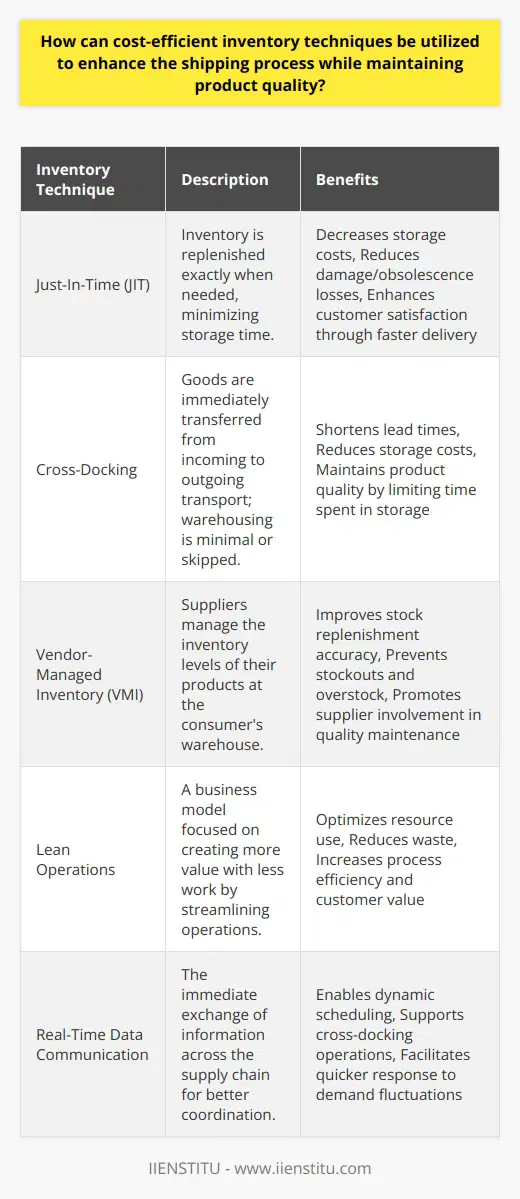
How should inventory be presented on the balance sheet to accurately reflect a company's financial position?
Subheadings:
Inventory Valuation Methods
Justification for Inventory Presentation
Accurate Reflection of Financial Position
Inventory Valuation Methods
To accurately reflect a company's financial position, inventory should be presented on the balance sheet using an appropriate valuation method. Inventory valuation methods include the first-in, first-out (FIFO), last-in, first-out (LIFO), and the weighted average cost method. The selection of a suitable inventory valuation method depends on the nature of the company's business, the industry, and the financial reporting standards applicable in its jurisdiction.
Justification for Inventory Presentation
It is crucial to justify the inventory presentation on the balance sheet, indicating the rationale behind the chosen valuation method. This justification allows relevant stakeholders, such as investors, creditors, and regulators, to understand the company's financial position better. Furthermore, consistently applying the chosen inventory valuation method enhances comparability across periods and aids in assessing the company's financial performance.
Accurate Reflection of Financial Position
In order to accurately reflect a company's financial position, inventory should be presented at the lower of cost or net realizable value (NRV). This implies that if the market value of the inventory falls below its cost, the inventory must be written down to the NRV to reflect potential losses. Adopting the lower of cost or NRV principle prevents the overstatement of inventory and ensures that the balance sheet presents a reliable and transparent view of the company's financial position.
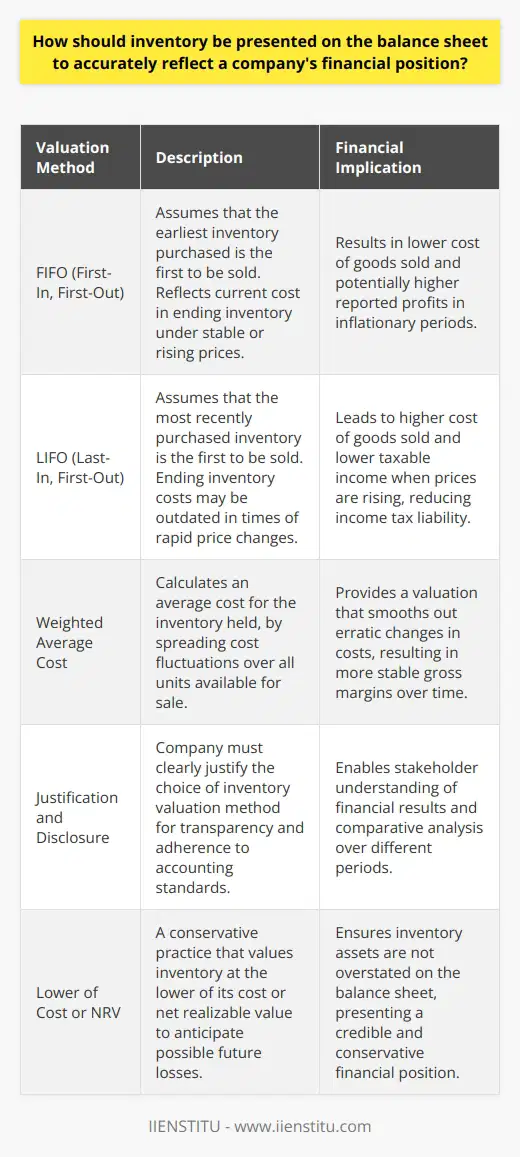
What is the role of inventory management in ensuring efficient shipping processes and timely delivery of goods?
Role of Inventory Management
Efficient Inventory Management
The role of inventory management in ensuring efficient shipping processes and timely delivery of goods is critical as it helps businesses to optimize their stock levels. This is accomplished by tracking the quantity, location, and availability of goods in real-time. By doing so, businesses can efficiently plan their shipping schedules, and reduce the instances of stockouts, overstocking, and delivery delays.
Optimizing Storage Space
Effective inventory management aids organizations in optimizing their storage spaces. By employing various strategies, such as slotting and layout optimization, businesses can store items in a systematic approach to ensure seamless picking, packing and shipping processes. Consequently, timely and accurate delivery of goods is ensured.
Enhanced Coordination Among Departments
Inventory management also plays a significant role in creating a smooth flow of information between various departments, such as procurement, finance, warehouse, and shipping. This coordination enables businesses to make well-informed decisions, which ultimately affect the efficiency of shipping processes and timely delivery of goods.
Improved Customer Satisfaction
Efficient inventory management leads to better customer satisfaction by ensuring that the right products are available at the right time. Timely delivery of goods directly impacts customer satisfaction as they receive their orders within the promised timeframe. This positive experience can potentially convert customers into repeat buyers and brand advocates.
Data-driven Decision-making
Inventory management provides valuable data and insights to businesses in order to make informed decisions about supply chain operations. This data-driven decision-making allows organizations to reduce lead times, improve shipping processes, and maintain an optimal level of inventory. In turn, timely delivery of goods is achieved.
Conclusion
In summary, inventory management plays a crucial role in ensuring efficient shipping processes and timely delivery of goods. It enables businesses to maintain optimal stock levels, optimize storage space, enhance coordination among departments, improve customer satisfaction, and make data-driven decisions about their supply chain operations. Consequently, the effective management of inventory directly impacts a business's success in delivering goods in a timely manner.
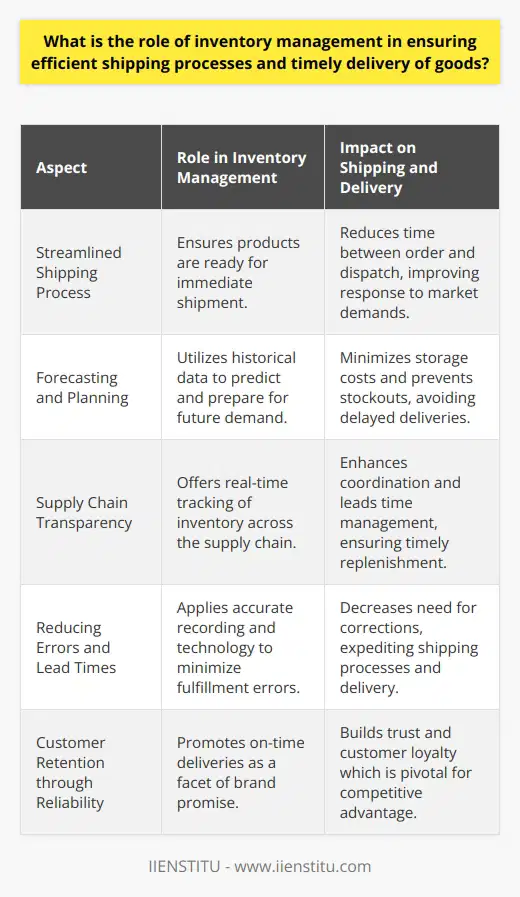
How do you account for finished goods inventory when considering various valuation methods and their impact on the overall financial performance of a business?
Valuation Methods and Impact on Performance
One crucial aspect of accounting for finished goods inventory is determining the valuation method, which directly affects the overall financial performance of a business. There are three main valuation methods to consider: the First-In, First-Out (FIFO) method, the Last-In, First-Out (LIFO) method, and the Weighted Average Cost method (WAC). Each method possesses unique advantages and disadvantages and serves various management strategies and financial reporting purposes.
FIFO Method
The FIFO method entails valuing the ending inventory based on the earliest purchased products' costs. Consequently, it produces an inventory value that reflects the current market cost of the items. As a result, businesses using this method are likely to experience increased profitability and higher income taxes due to the rising market prices. The FIFO method fosters more accurate financial reporting and aids companies in managing assets effectively.
LIFO Method
Contrarily, the LIFO method values the ending inventory based on the most recent purchased products' costs. This method results in a valuation that represents the items' historical costs and, in the context of rising prices, yields a lower inventory value compared to the FIFO method. The LIFO method offers the advantage of decreased taxes and improved cash flow but may understate a company's net income and lead to poor performance in financial ratios.
WAC Method
The WAC method offers a balanced approach to inventory valuation by computing the mean value of all products in inventory. This method mitigates the impact of price fluctuations on financial performance by producing a smoother, more consistent valuation compared to FIFO and LIFO. However, the WAC method can be arduous to manage, as it requires constant calculation and updating of inventory costs.
Impact on Financial Performance
The chosen inventory valuation method significantly influences a company's financial performance, especially in the context of rising market prices. By adopting the FIFO method, a business can bolster reported performance through higher profitability, yet concurrently face a heavier tax burden. Conversely, adopting the LIFO method can minimize taxes and enhance cash flow but may also undervalue the overall financial standing. The WAC method, though more labor-intensive, offers balanced financial performance and stability by neutering the impact of market price fluctuations on inventory valuation. Ultimately, each valuation method serves specific business goals and managers ought to carefully consider their decision's implications on their company's financial health.
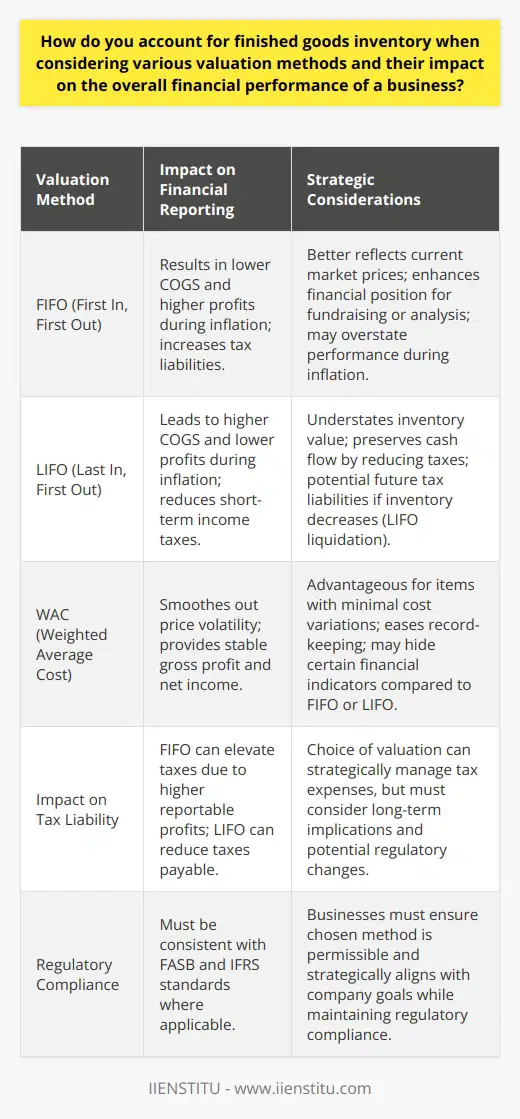
What are the key components of an effective inventory management system in the context of supply chain management?
Key Components of an Effective Inventory Management System
Accurate Demand Forecasting
An effective inventory management system in the context of supply chain management starts with accurate demand forecasting. By analyzing historical sales data and incorporating external factors such as market trends and economic indicators, organizations can better predict customer demand patterns. This enables them to make informed decisions about inventory levels and purchasing activities, thus reducing excess stock and stockout situations.
Optimal Reorder Points
Establishing optimal reorder points is another critical component of an effective inventory management system. By factoring in lead times and supplier reliability, organizations can determine when to place orders for new inventory to meet customer demand while minimizing holding and stockout costs. This ensures a balance between having sufficient stock on hand to meet customer needs and avoiding unnecessary expenses related to excess inventory.
Inventory Classification and Prioritization
Implementing inventory classification and prioritization strategies, such as the ABC analysis, allows organizations to focus their resources on items that have the most significant impact on customer satisfaction and profitability. By classifying inventory based on value, demand, and turnover, supply chain managers can allocate resources and effort more efficiently, improving overall inventory management effectiveness.
Real-Time Visibility and Tracking
Real-time visibility and tracking of inventory levels and movement across the supply chain are crucial for managing stock effectively. Using technology such as barcode scanners and inventory management software can provide accurate, up-to-date information about inventory levels and movement. This enables organizations to make timely decisions and reduces the risk of stockouts or overstock situations.
Regular Audits and Reconciliation
Finally, regular audits and reconciliation play a vital role in maintaining an effective inventory management system. By conducting physical inventory checks and reconciling recorded data with actual stock levels, organizations can identify discrepancies, address potential issues, and ensure the accuracy of their inventory records. This, in turn, contributes to better decision-making and improved overall supply chain performance.
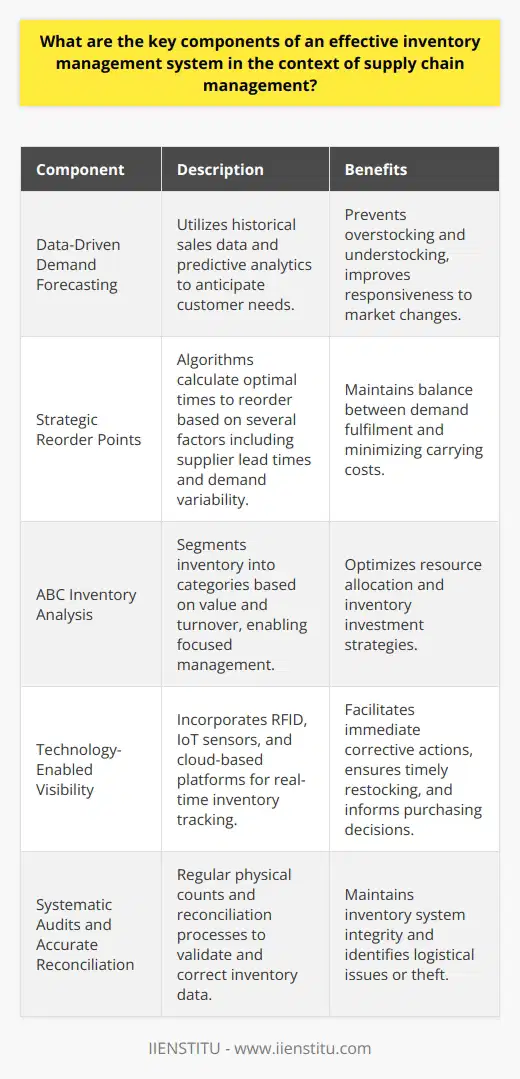
How can demand forecasting and inventory optimization techniques be integrated into a supply chain to improve inventory management outcomes?
Integrating Demand Forecasting
Incorporating demand forecasting into a supply chain is essential to achieve improved inventory management outcomes. Through accurate demand predictions, businesses can make informed decisions on purchasing, warehousing, and transportation. By using historical data and identifying trends, organizations can anticipate fluctuations in demand and adjust their inventory levels accordingly. This proactive approach ensures that stock levels are optimized, leading to reduced holding costs and minimized stockouts.
Inventory Optimization Techniques
Several inventory optimization techniques can be utilized to complement demand forecasting for improved inventory management. One such technique is the Economic Order Quantity (EOQ) model, which calculates the optimal order quantity minimizing the total cost of inventory. By considering ordering, holding, and shortage costs, businesses can determine the appropriate balance between overstocking and understocking.
Another method is the ABC inventory classification system, which categorizes products according to their importance or value. By prioritizing high-value items (A-items) and ensuring their stock availability, organizations can optimize their inventory management efforts and focus resources on critical products.
Integrating Order Management Systems
Combining demand forecasting and inventory optimization techniques with modern order management systems is a practical approach to improving inventory management outcomes. These systems enable real-time tracking of inventory levels across multiple locations and platforms, providing organizations with a comprehensive understanding of their stock status. Additionally, order management systems can generate automatic replenishments based on predefined criteria, reducing the risk of stockouts and enhancing customer satisfaction.
Data-Driven Decision Making
Utilizing data and analytics is critical for the successful integration of demand forecasting and inventory optimization techniques into a supply chain. By collecting, analyzing, and interpreting data from various sources, organizations can identify patterns, trends, and correlations that inform inventory management decisions. Regularly updating forecasts and adjusting inventory optimization strategies in response to changing market conditions and business priorities ensures continuous improvement in inventory management outcomes.
In conclusion, integrating demand forecasting and inventory optimization techniques into a supply chain can significantly improve inventory management outcomes. This integration enables organizations to make data-driven decisions and streamline order management processes, ultimately reducing costs, enhancing customer satisfaction, and improving overall business performance.
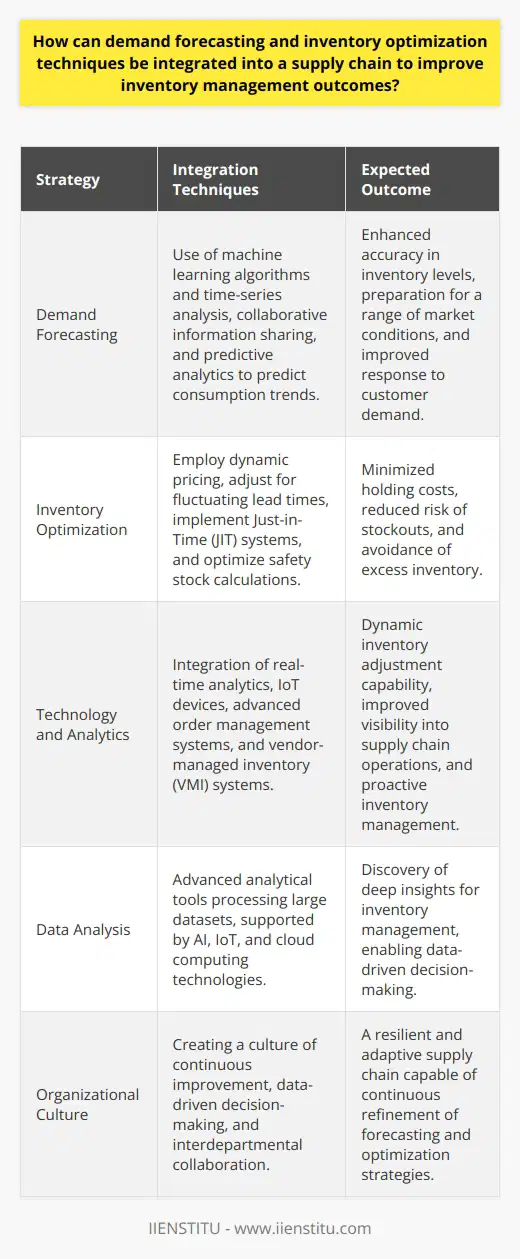
In what ways do advancements in technology, such as artificial intelligence and blockchain, influence the inventory management process within modern supply chains?
Impact on Inventory Planning and Forecasting
Advancements in technology, including artificial intelligence (AI) and blockchain, significantly influence inventory management processes within modern supply chains. AI streamlines the planning and forecasting process by analyzing a vast data pool, predicting customer demand patterns, and identifying potential bottlenecks. Consequently, businesses can make data-driven decisions to optimize inventory levels, reducing holding costs and stockouts.
Enhanced Data Visibility and Collaboration
Blockchain technology drives supply chain transparency by providing a secure, decentralized platform to track and share real-time inventory data across all supply chain partners. This enhanced visibility into inventory levels and movements ensures seamless collaboration among stakeholders and minimizes the need for manual data reconciliation. As a result, organizations can make accurate forecasting decisions and manage inventory positions more effectively.
Automated Reordering and Stock Replenishment
AI-powered inventory management systems facilitate automated reordering and stock replenishment, which are crucial steps in maintaining optimal inventory levels. Predictive analysis algorithms evaluate current inventory status, historical sales data, and lead times, ultimately triggering the procurement of products when they reach their reorder point. This automation prevents stockouts, overstocking, and wasted resources, ultimately improving customer satisfaction and overall operational efficiency.
Reinforced Traceability and Counterfeit Prevention
Integrating blockchain technology into inventory management enhances product traceability and counterfeit prevention measures. By recording each product's unique data on an immutable ledger, blockchain creates a tamper-proof digital footprint throughout the supply chain. This increased traceability ensures that all stakeholders can verify product origins, monitor stock movement, and maintain product authenticity, thus ensuring inventory accuracy and reducing losses associated with counterfeit goods.
Achieving Full Integration and Optimizing Supply Network
The combination of AI and blockchain technologies enables seamless integration across all inventory management stages – from procurement to customer delivery. Through AI-driven optimization, businesses can streamline supply chain networks to achieve just-in-time production and distribution, significantly reducing lead times and the need for buffer stock. Additionally, blockchain alleviates compliance and ethical concerns within global supply chains and encourages sustainable inventory management practices.
In conclusion, advancements in AI and blockchain technologies have greatly impacted inventory management processes, leading to improved forecasting, transparency, automation, traceability, and overall supply chain efficiency. By adopting these technologies, companies can optimize their inventory management approaches and thrive in an increasingly competitive landscape.
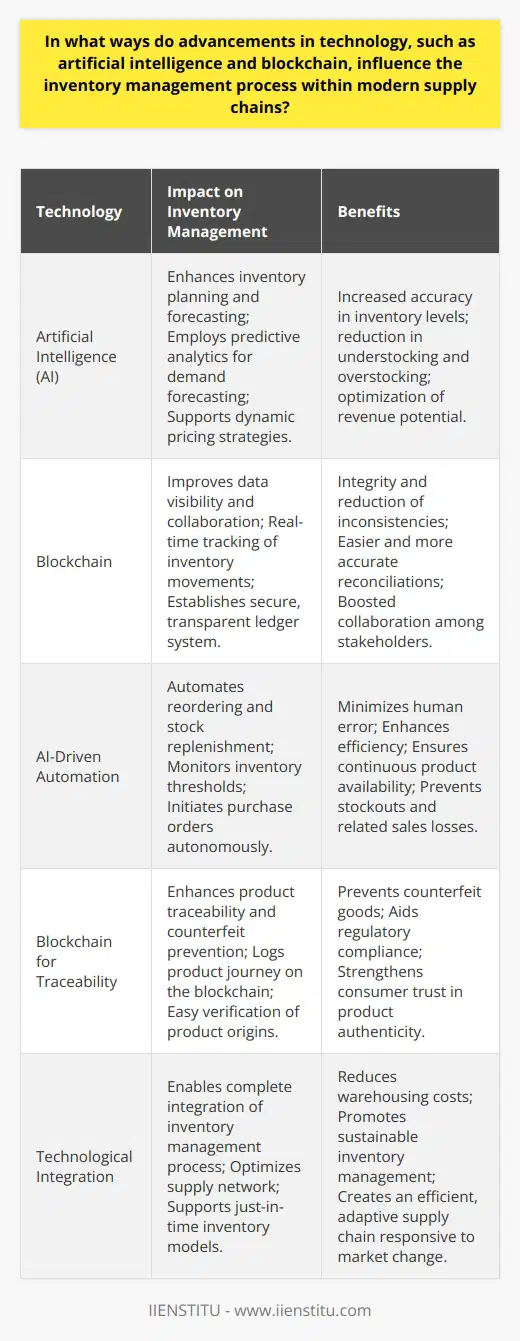
What are the essential elements of inventory control that contribute to an efficient and effective supply chain management system?
Essential Elements for Inventory Control
**Accurate Demand Forecasting**
One of the pivotal factors that contribute to efficient and effective supply chain management is accurate demand forecasting. Anticipating customer demands enables businesses to optimize stock levels, minimize holding costs, and ensure timely deliveries. Moreover, it helps in reducing stockouts and overstock situations, improving customer satisfaction, and prompting operational efficiency.
**Safety Stock Management**
Safety stock management plays an indispensable role in inventory control for a well-functioning supply chain system. It acts as a buffer against uncertainties in demand and lead time variations, ensuring smooth operations and preventing stockouts. Efficient safety stock management involves assessing and monitoring inventory levels regularly, and adjusting safety stock levels based on changing patterns in demand and lead times.
**Centralized Inventory Database**
A centralized inventory database significantly contributes to supply chain efficacy by offering real-time visibility of stock levels across multiple locations. It streamlines the procurement, tracking, and replenishment processes, and prevents information silos that can lead to inefficiencies and errors. Furthermore, a centralized database allows for better coordination among various departments and facilitates informed decision-making.
**Periodic Inventory Reviews**
Conducting regular inventory reviews is essential for maintaining the efficiency of a supply chain. Periodic reviews help businesses identify discrepancies, excess stock, and inefficient practices, allowing them to rectify issues in a timely manner. Furthermore, these reviews provide valuable insights into consumer trends and preferences, enabling companies to refine their inventory control strategies and enhance their market responsiveness.
**Supplier Relationship Management**
Effective supplier relationship management is another critical element for efficient inventory control. Establishing strong relationships with reliable suppliers leads to improved product quality, shorter lead times, and better negotiation of supply contracts. In addition, fostering trust and collaboration with suppliers facilitates information sharing, promoting better demand forecasting and prompt response to market fluctuations.
In conclusion, a combination of accurate demand forecasting, safety stock management, centralized inventory database, periodic inventory reviews, and supplier relationship management constitute the essential elements of inventory control. These components contribute to developing an efficient and effective supply chain management system, which is vital for achieving operational excellence and maintaining a competitive advantage in today's global business environment.
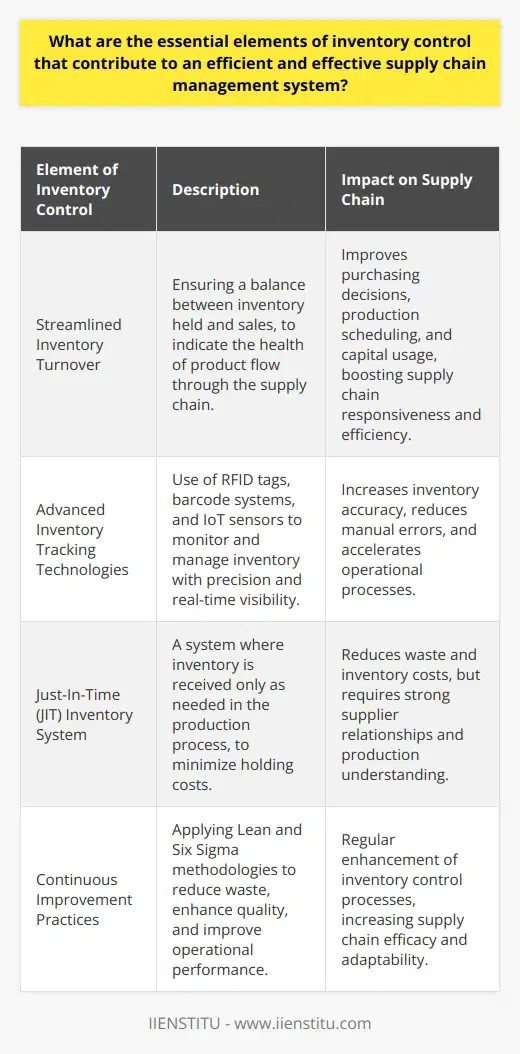
How does the implementation of inventory management software impact the overall efficiency and accuracy of supply chain operations?
Impact on Efficiency
The implementation of inventory management software significantly enhances the overall efficiency of supply chain operations. The automation of essential processes, such as tracking and managing stock levels, reduces the time and effort spent on manual data entry by employees. Additionally, these software systems streamline the inventory restocking process, ensuring that adequate supplies are maintained, thus avoiding stockouts and excess inventory holding costs.
Enhanced Accuracy
Inventory management software also improves the accuracy of supply chain operations by providing real-time, up-to-date information on stock levels, sales, and order statuses. By eliminating the possibility of human error in recording and maintaining these crucial data points, the software ensures that decision-makers can rely on the available data to make informed choices. Accurate inventory data further enables businesses to plan their production, procurement, and sales efforts in a more coordinated manner, leading to more effective resource allocation.
Reduced Lead Time
One of the most significant advantages of implementing inventory management software is the reduction in lead times. These systems optimize order processing, pick, pack, and ship activities by employing efficient techniques such as batch picking and barcoding, which streamline the warehousing operations. By decreasing the time taken to fulfill orders, supply chain operations become more agile and responsive to customer demands, ultimately enhancing customer satisfaction and facilitating better sales performance.
Improved Supplier Collaboration
Inventory management software also fosters greater collaboration between businesses and their suppliers by providing transparent and accessible information on inventory levels, demand forecasts, and supplier performance metrics. This improved access to data enables suppliers to react more quickly to changes in demand, ensuring that stock levels are replenished promptly and consistently. The enhanced collaboration leads to stronger supplier relationships, which are essential in building a resilient and agile supply chain.
In conclusion, inventory management software plays a critical role in increasing the overall efficiency and accuracy of supply chain operations. The automation of essential processes, real-time data availability, reduced lead times, and improved collaboration between businesses and suppliers contribute collectively to enhanced supply chain performance. Companies that adopt inventory management software are better positioned to meet customer demands promptly, manage resources effectively, and build sustainable competitive advantages.
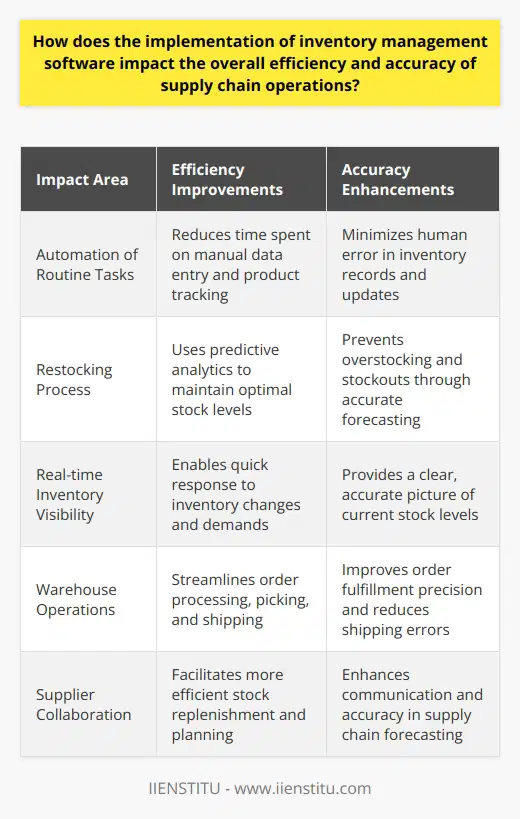
To what extent does the integration of sustainability principles in inventory management strategies influence the environmental footprint and long-term viability of a supply chain?
Integration Extent
The extent to which sustainability principles are integrated into inventory management strategies significantly impacts the environmental footprint and the long-term viability of a supply chain. The adoption of sustainable practices in the management of inventory, such as reduction in packaging materials or implementing recycling programs, can lead to decreased environmental impact. Moreover, adopting sustainable practices can have a positive effect on the overall performance of the supply chain, with potential cost savings and enhanced efficiency.
Environmental Footprint Reduction
Integrating sustainability principles into inventory management strategies can lead to a reduction of the environmental footprint through several mechanisms. For example, minimizing waste by optimizing inventory levels helps to reduce the amount of packaging materials, transportation emissions, and energy consumption associated with excessive inventory. Implementing more stringent environmental standards for supplier selection can also contribute to limiting the negative environmental impact from raw material sourcing to product manufacturing.
Long-term Viability Enhancement
The incorporation of sustainability principles into inventory management can enhance the long-term viability of the supply chain by providing a competitive advantage through cost reduction, increased operational efficiency, and improved brand image. Companies that prioritize sustainability practices in their inventory management strategies demonstrate a commitment to environmental stewardship and resource conservation. This proactive approach not only attracts environmentally-conscious consumers, but also helps to ensure compliance with increasingly stringent environmental regulations and reduces the risk of potential costs associated with non-compliance.
Collaborative Approaches
Furthermore, adopting a collaborative approach to sustainability within the supply chain can improve the long-term viability of the entire system. When companies work in partnership with suppliers, distributors, and customers to address environmental challenges, they can develop innovative solutions to improve efficiency, lower costs, and reduce environmental impact. This collaboration fosters a culture of continuous improvement and shared responsibility for sustainability throughout the supply chain, leading to increased profitability and resilience for all stakeholders.
In conclusion, the integration of sustainability principles in inventory management strategies plays a crucial role in reducing the environmental footprint and enhancing the long-term viability of a supply chain. By adopting sustainable practices, from inventory optimization to supplier selection, a company can achieve both environmental and financial benefits, improving brand image and complying with regulations. The development of collaborative approaches and fostering a culture of shared responsibility for sustainability further strengthens the resilience and competitiveness of the supply chain.
